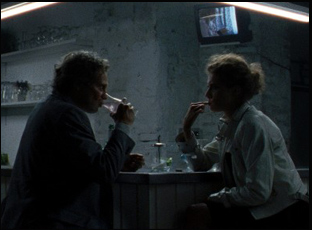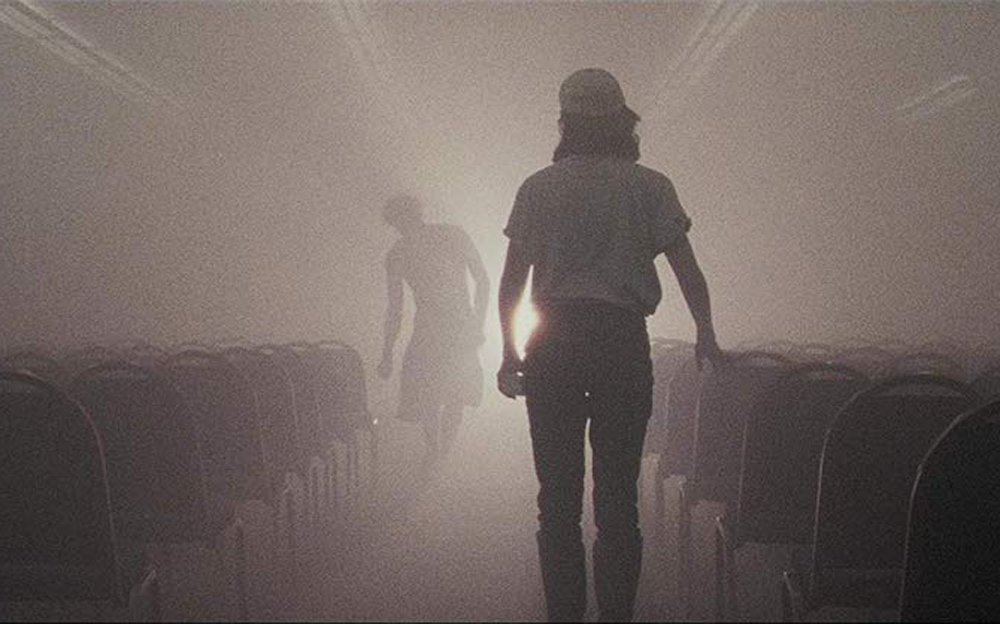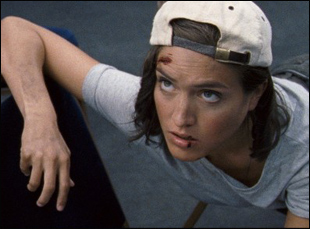Tilman Singer hasn’t really been able to stay in one place for too long, ever since his debut feature “Luz” premiered at the Berlin Film Festival last year.
“There were so many festivals that at some point I even got a little bit of traveling fatigue, which I never thought would happen,” Singer admits. “There were so many planes and hotels, but I do not want to complain at all. Everything went way beyond what we thought would happen with it when we produced it at our art school. We thought it might go to one or two festivals and that’s it. Like, ‘Okay, we have a calling card to maybe make another movie.’”
The problem is that Singer’s thesis film turned out too well and in making a thriller that could work within the confines of a tight budget and limited locations, surely the irony isn’t lost on the filmmaker that “Luz” has traveled well beyond anywhere he could imagine. Still, his imagination is quite expansive as “Luz” attests, better described in experiential terms than narrative ones as he puts audiences squarely inside a demonic possession. At first, this opening of Hellmouth looks relatively benign, following the young Chilean woman of the title (Luana Velis) when she shows up at a police station, looking to report an incident while working as a cab driver, and a psychotherapist (Jan Bluthardt) drowning his sorrows at a nearby watering hole gets a call from the cops to evaluate her. But once the questioning starts, it’s clear that this will be no standard interrogation as hypnotism is employed as a tactic and as the police enter Luz’s mind, so does Singer, as memories crop up of her time in Catholic School while trying to understand what exactly happened to her a few hours before.
Time becomes part of the way you grow closer to Luz as her own fuzziness would seem to infect the fabric of the film, with grain-inflected 16mm not only reminding of the ‘70s giallos that Singer’s debut seems to be a worthy successor to but acting as an agent of disorientation when it’s difficult to place exactly when the situation unfolding with other hints around the frame suggesting a number of different eras. Unsettling chronologically, the film makes time stand still in wrapping itself around you with its sound like a snake, from a seductive score from Simon Waskow with jarring interludes to immersive sound design that takes hold unseen, much like the supernatural forces that come into play as the interview with Luz wears on. After a celebrated run on the festival circuit over the past year, the film is arriving in theaters this week and Singer spoke about growing up together with his production team, embracing the discipline that shooting on celluloid imposes and making the most of what resources were available.
I studied at an art school in Cologne, Germany called the Academy of Media Art and it’s not a film school, but it has a big film department and this was my thesis and the thesis of my production designer Dario Mendez. We got our team together that we had for various short projects before and we worked overtime. [laughs] At first, I thought maybe of a 30-minute, medium-length film and then when I gave the cast of characters backstories, “I was thinking about who are they? What are they doing there?” And it grew into a short feature film very organically, always having the money limitations in mind. We got the funding from the state the school was in and obviously the school had cameras and editing rooms, so we got all of that, but I always had in mind what can we do with our budget without having something just done halfway. That’s how we decided to have this kind of chamber play [where] everything is in one place and the story we tell is just over the course of a couple of hours. The initial [idea] I had is that the big hypnosis [scene] in the middle [of the film] with the chair.
Is it true you did research into police interrogations first for that?
Yeah, when I thought I want to tell a longer story, I started doing research on police sketch artists – people that draw wanted or missing people – and I couldn’t really find a story I felt confident in enough to produce it, especially at the budget. But then I stumbled across interrogation and questioning techniques and eventually [found my way] over to hypnosis and hypnotherapy. That’s when it got really interesting because hypnosis in itself is very strange and potentially scary because you can influence a person so much. You can invade a person’s mind, so that’s where the supernatural stuff comes from, and then my wife is Colombian and she told me stories from her time in Catholic school for girls. None of the stories in the film happened to her. [laughs]. But [I was interested in this] feeling of restriction in general, so I mixed all of that together and that’s how it came out.

Yeah, I basically wrote everything into the film, and our sound designers are amazing, especially with Henning Hein, who did the mixing. I worked with him on basically every film I did before, so I was very, very aware of how important sound design is and how fruitful the process of working with him in postproduction is, so this time I actually wrote into the script everything you can hear and can see and cannot hear and who hears what. It’s really complicated and you didn’t have a good flow reading [the script], but it was important so that everybody would understand what would be going on at this moment because it shifts so quickly. The perspective is always changing.
The texture of the 16mm stock really adds to the experience as well. Did you have that in mind from the start?
I really like the format, especially because we were able to shoot on anamorphic lenses that were created for the new digital ARRI Alexa and RED cameras that use these new chips – that’s how it was explained to me by my dear friend and cinematographer. You can use those cameras [where] the chip size is almost the same size as a Super 16 frame, so you have new anamorphic lenses that you can use for the old gear and I love the feel of 16mm, not only the look of it, but I think you will always feel something is shot digitally, just for the reason that if you shoot digital, you can shoot as many takes as you want to. When you shoot on film, you really have to figure it out beforehand and I won’t say that makes it more dynamic, but you feel that – the shots have been more rehearsed or more chosen.

Not so much. I did some reading with actors. Two of them were in Munich and I took a train there and we read the bar scene, for example, and then we had a little get-together with Luanna Velis, who plays Luz and Jan Bluthardt, who plays the doctor, but other than that, I like to talk extensively to the actors and see if they understand what I’m going for, even though I may not be able to explain it correctly at that moment, [as well as] if they trust me. Obviously, I have to trust their ability to act – I knew all of them were great actors, so I wasn’t worried there and there’s really not much rehearsal upfront. But I really take my time on set and rehearse between the first initial technical rehearsal of where people are and blocking and when we shoot. And because we shoot on film, we always have to rehearse to a point like, “Okay, the next try will be better than every try before and also be good enough to record it,” so that’s when we record. Then you get this kind of extra little energy boost, which is great.
The locations are distinctive as well. How did you find them?
That was a nightmare because we shot it in Cologne where our art school was and it was a nightmare because there are three types of television channels in Cologne. It’s not a big city. There’s maybe a million people living there, so basically everything that’s abandoned has been [used] by TV [already], so the owners of places know how much they can ask for. [laughs] But we were really lucky that the city of Cologne actually suggested to us this building and made us a really good deal. I don’t know what it was, but it was next to nothing and they were super-friendly. We could shoot everywhere.

I agree with you on the score. [laughs] Simon [Waskow, the composer] is a very close friend of mine. All of my core creative team is, but Simon is someone I’ve known since we were 14 and we went to high school together, so I always give him very early drafts [of my screenplays], or not even drafts, but notes of what I’m working on and sometimes he starts working on things super early, especially for “Luz.” He came up with the song that Luz is singing in the film while we were shooting because he also did the sound recording on set and we were sure we were going to reuse this melody and the lyrics at different times in the score. Then sometimes I gave him temp tracks that he turned into something else. For example, I knew I wanted a very long track in the bar scene at the beginning and I think I gave him a temporary track that was Tangerine Dream and he made it a jazz drum track out of it, which I really, really love.
Then other times, he’d send me demos and when I started editing with them, they fit so good into what I’d come up with in the edit that we didn’t even change them – that’s a demo [during the scene] when the doctor changes his clothes and this was just [our composer] putting on a synthesizer, looking for a melody and sending me like a rough mp3. I think he said he came up with that being bored on Christmas Eve, so he sent me eight minutes of him looking for a melody and I just started editing to that and it came out great. We didn’t even change it. So it’s a lot of back-and-forth and I’m really thankful to have somebody so close to me and he gives me ideas and I give him ideas and we trust each other.
“Luz” opens on July 19th in Los Angeles at the Laemmle Monica Film Center and the Pasadena Playhouse 7 and New York at the IFC Center and the Nitehawk Cinema Williamsburg. A full list of cities and dates is here.





